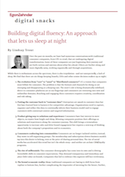Over the past six months, we have had numerous conversations with traditional consumer companies, from CPG to retail, that are undergoing digital transformation. Some of these companies are just beginning their journey and are both curious and anxious about what lies ahead. Others are further along and more digitally savvy, evolving organically and through acquisitions.
While there is enthusiasm across the spectrum, there is also trepidation—and not unexpectedly, a lack of sleep. We find that there are six things keeping boards, CEOs and other senior decision makers up at night:
- The evolution from “core” to “omni” to “distributed commerce”: It’s a truism that companies must follow the consumer. The problem is that the formats and channels for doing so are emerging and disappearing at a dizzying rate. The store’s role is being dramatically redefined; direct-to-consumer platforms are at our fingertips and consumers are venturing into new and unfamiliar domains. Reaching and engaging these customers requires creativity, coordination and risk taking.
- Putting the customer back in “customer data”: Enterprises are awash in customer data but few have learned how to harness it for competitive advantage. Organizations need to capture, organize and utilize this data to continually inform their business model and to engage customers with contextual content and targeted information.
- Product giving way to solutions and experience: Consumers have lost interest in mere objects, no matter how bright and shiny. Winning companies position their offerings as solutions and experiences along the consumer journey. This shift brings a tremendous opportunity to increase sales and drive brand engagement but requires a new way of thinking about both the company’s proposition and its economics.
- Consumers coalescing into communities: Consumers are no longer isolated entities; instead, they move in self-organizing groups. The membership and subscription-driven business models tap into this desire to belong, even at the price of sharing personal data. The rise of social media has accelerated this trend but isn’t the whole story—and neither are archaic CRM/loyalty programs.
- The rise of millennials: This consumer demographic has come into its own and is driving formidable shifts in consumer expectations. They demand transparency and immediacy and place little value on brands. Companies that fail to embrace this segment will face irrelevancy.
- The brutal economic reality: Many traditional companies are having to shift focus from topline to bottom line, further complicating the imperative of investing for the future. Further, they are at a stark disadvantage compared with start-ups, whose investors are willing to forego profit for growth. To compound the challenge, many legacy companies struggle with the speed of change and question their own agility in adapting. And if that weren’t enough, unpredictable geopolitics adds another layer of uncertainty.
Meeting these challenges depends on having the right leadership. But this is not just a question of having the right chief digital officer or chief marketing officer. The real issue is building agility and digital fluency more broadly throughout the organization. We’ve been able to help our clients do that in a number of ways:
- In the boardroom, we work with nominating committees to help them assess the board’s overall comfort with digital transformation and to identify potential board members who can bring needed experience and perspective.
- We help companies establish digital advisory boards of external business leaders with deep experience in digital organization and transformation. These boards work directly with the company’s board of directors and senior management to provide concrete guidance on the digital transformation process, acting as a sounding board for the sensitive issues that arise along the way.
- Digital transformation raises numerous questions regarding organizational structure. We help enterprises define their operating models and then design a structure to fit, drawing upon our knowledge of best practices and the digital journeys of others.
- Finding, developing and retaining the right talent is critical for starting and sustaining transformation. But mapping the optimal talent management strategy is difficult when industry silos are dissolving, new roles are being established and new competencies are given priority. We help human resources leaders sort through these complexities to build the transformational teams they need.
- Through the Innovation Quotient, a service we offer in partnership with Linda Hill, a Professor at Harvard Business School and one of the world’s foremost authorities on innovation in the workplace, and her team at Paradox Strategies, we assess organizations’ capacity for innovation and provide concrete strategies for change.

Building digital fluency across the organization is central to the transformation process. And because different points in the organization have different requirements, having a multifaceted approach is critical for success—and for our ability to get a good night’s sleep.






